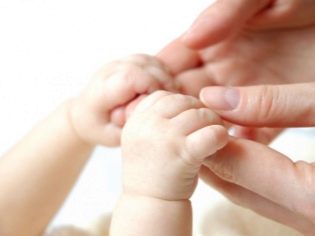When does a baby start keeping its head on its own?
A newborn baby looks weak and defenseless. He almost does not control the movement of his arms and legs, eyeballs. All the muscles of the crumbs are in a little stress. For the months spent in her mother's womb, the baby has become accustomed to experiencing tightness, and therefore it is very difficult for him to adapt to the spacious new world in which he came on his birthday. Each new skill that the kid “acquires” gives him new opportunities to comprehend the world.
One of the first skills is the ability to keep your head. In this article, we’ll tell you about when babies start keeping their heads on their own and whether parents can influence the speed of mastering this skill.
About skill and terms
The passage of the physical development of the child by nature is provided at certain stages. No subsequent can come before the previous one is mastered. As the congenital muscle tone decreases, the nervous system improves, muscle tissue, bones grow up, mental development, the child has the opportunity to learn a new skill.
The first skill is the ability to lift and hold the head vertically. It is clear that at once the child will not learn to keep his head even and long, because it requires a certain training of the neck muscles; but the first attempts to raise the head in the prone position on the tummy can be made by the child as early as one and a half to two months. Attempts to be quite timid, parents can pay attention to the fact that the child does not hold the head for more than a few seconds, besides it can keep it a little crooked. As the muscles of the neck and cervical vertebrae are strengthened, the rise of the head will be more and more confident, and the retention will be long.
Usually by 2-3 months, children already know how to lift the head and hold it vertically for up to several minutes. If the baby began to hold his head, then he quickly realizes what advantages it gives him - the review expands. To twist the head upright, turning it to the right or left, the babies begin a little later - closer to 3.5-4 months. Last of all, the children begin to raise their heads from the supine position. They will learn this only by 5 months.
You need to understand that holding the head for the baby is an extremely complicated task. After all, the head of newborns is quite large and heavy, and the skill involves holding the weight of the head with the help of the vertebrae and neck muscles. That is why a lot of factors influence the speed of appearance of a skill. The first to develop the rear neck muscles, lateral - in the last turn.
Why doesn’t the child keep his head on time?
If the child develops according to the schedule, the parents are incredibly proud of it. But if the time came, and the baby did not begin to hold the head, then the mothers are usually very worried and torture themselves with conjectures. In fact, the norms that parents are guided by are rather conditional. The baby is not at all obliged to develop as they prescribe, since it can have good reasons for the individual characteristics of physical development.
The main reason is gestational age. If the baby was born prematurely, then it takes more time to strengthen the neck muscles. It is possible that premature babies will begin to master this skill only closer to 3 months. This is not a reason for excitement and experience.You just need to create optimal conditions for the child so that he could grow and develop.
The second important factor is the health of the crumbs. Later, the children who had suffered intrauterine hypoxia, experienced a state of acute hypoxia during difficult births of the mother, who received birth trauma and had any congenital diseases, begin to hold their heads later than their peers. If the baby in the first months of life was sick with colds or viral diseases, he will also develop more slowly than healthy and strong peers.
The ability to lift the head and hold it upright is affected and weight of the child. If the peanut was born large and scored more than the norm during the first month, what the pediatrician will surely inform parents of at the first medical examination at 1 month, then the chances of having previously mastered motor skills are low. Most likely, the baby will begin to hold his head no earlier than 3 months. But low-weight babies also develop with some delay - in order for their muscles to hold the load, they first need to gain normal body weight.
Baby's temperament is an important factor influencing his desire to learn to keep his head upright. A lazy, melancholic crumb is unlikely to strive earlier to master a new position of the body, which cannot be said about curious and cheerful choleric and sanguine people.
The final touch is child living conditions. If a mother does everything possible to strengthen his health, muscles, and immunity, then there is no reason not to raise her head. Children whose physical development is given less attention later learn their first motor skill.
Why does a child hold his head unevenly?
As already mentioned, the reason may lie with insufficient maturity of the neck muscles. But with the pediatrician, this issue must be discussed without fail, at least because the reason may lie in the crooked.
In this case, the child will always tilt his head in a certain direction, and turning the head in the direction of defeat will be extremely difficult or impossible. Unnatural posture, if the child holds his head crookedly, with a bias on one side, should be a reason for consultation not only with a pediatrician, but also with a children's orthopedist.
Krivosheya in infants straightens. Parents are recommended therapeutic massage, gymnastics from the exercise therapy program. But an orthopedist and pediatrician should appoint and show the exercises and techniques of medical procedures. On their own, it will be difficult for parents to take into account the degree of deviation and to plan physical impact adequately.
Opinion of Dr. Komarovsky
The ability to hold one's head is an important diagnostic sign, which is why the pediatrician at the reception necessarily clarifies whether the tiny one keeps the head. The famous pediatrician Yevgeny Komarovsky advises not to panic, if the toddler is somewhat delayed in physical development, but also not to overlook possible pathologies. If, after 3 months, the child does not even try to raise his head, lying on his stomach, Yevgeny Komarovsky advises to always consult a doctor.
According to the doctor, problems with holding the head usually arise much less than problems with other, more complex motor skills, such as sitting, coups, crawling, standing, walking. Parents should not try to hold the baby’s head with their own hands, trying to help him.
The little ones do not tolerate such shameless treatment with their own head, they immediately begin to desperately resist. This is well known to all mothers who, at the dawn of breastfeeding, tried to hand the head of the child towards the breast. The reaction will be the opposite. In addition, the inept power actions of adults can harm a child, injure him.
Komarovsky considers the most optimal natural development, when the baby begins to lift and hold his head himself, without coercion, even with some delay.When his muscles and vertebrae are ready, the baby will definitely begin to hold his head, and he will do it quite confidently. If parents want to help the little one, Komarovsky recommends paying special attention to gymnastics, massage and swimming, walks in the fresh air.
Too much delayed skill will prevent the study of other movements, without the ability to hold the head, the child cannot learn to roll over to the side, cannot sit down. Therefore, it is important to respond in a timely manner.
Gymnastics and massage
No special effort charging and tonic massage will not require. To strengthen the muscles of the neck, you will need simple actions that mother already does daily. The most effective exercise is laying on the stomach. Such a posture for the baby is very useful for a number of reasons: his intestinal gaziki are moving away faster, infantile colic is relieved, the anterior abdominal wall and back are strengthened. Holding the head becomes quite a natural continuation of being in such a position, because after a month the child begins to be interested in surrounding sounds, he will try to turn his head. From the prone position, it is possible to do this only by lifting the head.
Laying the baby on the belly, the mother should take into account his weight, degree of prematurity, if the baby was born before the deadline set by the midwives, his temperament and mood. If the baby is not well, or if he has a bad mood, gymnastics and massage are not good for him. On the baby’s tummy you can lay out after the umbilical wound heals, that is, from about 2.5 - 3 weeks of life.
In order for the baby to quickly learn to hold the head, the mother needs to be able to draw his attention to herself. Therefore, it is important to communicate with the child while he is lying on his tummy, singing something, telling poems, using musical toys or making any sounds of toys (tweeters, rattles).
Useful will be pull-ups on the handles, which the mother can include in the list of exercises for the morning exercise. An adult gives the baby a grab on his fingers and begins to gradually raise the child above the surface of the massage table. But - for a short distance, not verticalizing! In this position, the muscles of the back of the neck are perfectly trained, which will help, in the end, to master a new skill.
It is possible to train the neck muscles in an upright position on the mother’s arms. In this case, the mother should support the child with one hand under the buttocks, the second - in the neck and head. It is necessary to carry the child correctly so as not to damage the immature vertebrae.
Any techniques of general classical massage in combination with such positions have a beneficial effect on strengthening the muscles of the neck. Useful and swimming in a special orthopedic circle, which is worn on the neck and fasten. A baby can swim in such a circle from 1 month, if it is given permission by a neurologist.
About the "early" kiddies
The inferiority complex in the newly-made mother may well cause the reviews of other mothers, who are very proud of the early development of their children. If a woman claims that her child began to hold her head confidently in one month, then there is no reason not to believe. But also a reason for joy - alas! - also. Most often, the early establishment of the skill indicates the presence of hypertonicity of the neck muscles, and may also indicate increased intracranial pressure. Early lifting of the head is also a reason for consulting with a doctor, and not at all a sign of the “genius” of the child. A healthy child in 1 month should not keep his head himself.
The first attempts of the baby to raise the head, however, can occur in a month. But in this matter it is very important how long the crumb can keep his head. A healthy baby acquires the skill gradually, improves every day, copes better and better. If the pussy abruptly and suddenly began to hold his head, this is an alarming sign of a violation of muscle tone.
In the next video, Dr. Komarovsky will examine two main questions that most parents care about: whether their child meets the standards and whether he fits within the expected development time frame.


























